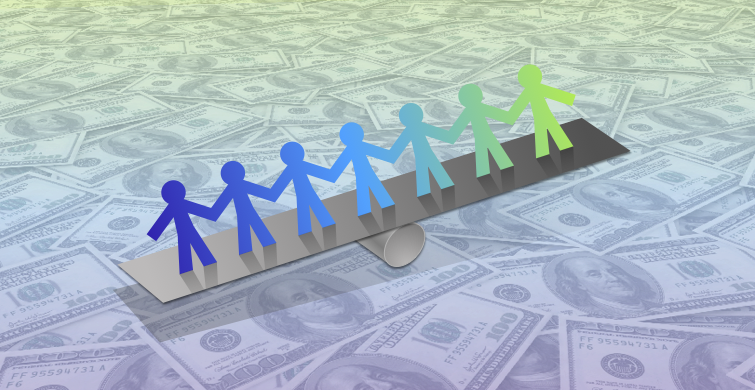Data on the Racial Wealth Gap

From criminal justice to unemployment to health outcomes, news about racial inequity seems to be saturating the national discourse. To start with, you can use PolicyMap to get a baseline understanding of race and income in a given area. The persistence and magnitude of the growth in economic inequality along racial and ethnic lines (often referred to as the racial wealth gap) is among the topics gaining prominence. For example, a recent study by Demos reported the sobering finding that Black and Latino two-parent families have half the wealth of White one-parent families. Another recent report determined that White Americans hold, on average, 7 times as much wealth as African-Americans (and 6 times as much as Latino ones). Eliminating the racial wealth gap has been increasingly addressed as a policy, not a behavior, issue, that will require an increased focus on structural and institutional racism. In the words of Brandeis sociologist, Thomas Shapiro, “History and legacy created the racial gap. Policies have maintained it.”
As an attendee at last week’s Federal Reserve System Community Development Research Conference, which was titled The Economic Futures of Kids and Communities, it was not a surprise to see ample focus placed on the racial wealth gap. Vibrant discussion around how housing and education impact the wealth divide left me wanting to explore this division in a geographic way. While there is no one measure that quantifies disparities along racial and ethnic lines, a number of drivers that factor into the racial wealth gap can be explored using PolicyMap.
Homeownership
With home equity being one of the most significant drivers of wealth for families in the U.S., the disparity in homeownership rates is problematic. Research shows that Black families have lower homeownership rates, lower average home values, and were hit harder by the Great Recession. With Black households having less inheritance to pass on between generations (with inheritance being an important contributor to a down payment on a house for many people), coupled with persistent residential segregation, low homeownership rates cost Black households tens of thousands of dollars in home equity. Below, the maps of Boston and its surrounding suburbs show that even within the city, close to half of White households own their homes, while less than 20% of Black households do.
Would mitigating these disparities in homeownership rates substantially reduce the racial wealth gap? A growing body of research suggests that it would. Corporation for Enterprise Development (CFED)’s recent report, A Downpayment on the Divide, provides a long list of policy suggestions to help close this racial home equity gap. Their recommendations include a wide range of polices aimed to reform the federal income tax code, increase access to quality mortgage credit and protect against predatory lending and discrimination.
Data
Educational Attainment By Race
Source
Find on PolicyMap
- Education
- Population
- Educational Attainment By Race
Education
College education is linked to higher lifetime earnings, and access to college is often seen as one of the most important ways to achieve economic mobility. College graduates are also more likely to have jobs with perks like health, vacation time and retirement benefits. However, rates of college attendance and completion varies greatly among Whites and Blacks. The maps below show patterns of disparity in the attainment of college degrees along racial lines in the Memphis area.
Thus, would increasing college attendance and graduation rates for people of color help level the economic playing field? According to researchers at last week’s Federal Reserve conference’s session on “Child Poverty, Inequality and Adult Outcomes”, this would help, but only modestly. William Emmons’s (of the Federal Reserve Bank of St. Louis) latest research suggests that higher education can only somewhat reduce the racial wealth gap; he ultimately assesses the gap to be “deeply rooted in observable factors that may include discrimination or other long-lasting disadvantages.”
Income
Income impacts the ability to both spend in the present and to accumulate wealth, and growing income inequality cannot be ignored in the conversation about the racial wealth gap. Access to the labor market is not only a primary driver of the racial wealth gap, but according to one study, it accounts for 20% of its growth in the last 25 years.
The maps below show the magnitude and spatial distribution in income disparities between Whites and Blacks in the City of Baltimore.
Homeownership, college education, and income are certainly not the only factors contributing to the racial wealth gap, but exploring these data can provide useful insight into the extent of and the spatial distribution of the wealth gap in your city. When exploring the data and considering policy implications, it is important to keep in mind that equal achievements, such as homeownership and income gains, bear unequal wealth returns for Whites and Blacks. In light of this, Brandeis sociologist Thomas Shapiro urges policymakers to always consider whether policies meant to do good for all are going to have the impact of doing better for some than for others. To assist in assessing whether a given policy will improve or aggravate wealth inequities, Dr. Shapiro and his colleagues at Brandeis’s Institute on Assets and Social Policy recently released the Racial Wealth Audit website. Hopefully, the use of resources such as this, as well as continued examination of the data that is available, will result in a shift towards policies and practices that can help narrow the racial wealth gap.